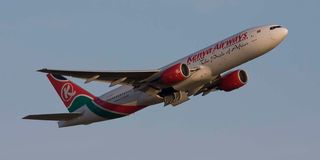Regulator shuts KQ from Wajir, Ukunda, Mara, Homa Bay, Lokichogio and Isiolo

Kenya Airways liner in flight. The Kenya Civil Aviation Authority has rejected an application by the national carrier for permission to fly to Wajir, Ukunda, Homa Bay, Lokichogio, Isiolo, and Maasai Mara.
The aviation regulator has denied Kenya Airways (KQ) an air service licence to ply six new local routes, dealing a blow to its plans to increase operations in the local market.
The Kenya Civil Aviation Authority (KCAA) rejected an application by the national carrier for permission to fly to Wajir, Ukunda, Homa Bay, Lokichogio, Isiolo, and Maasai Mara.
“Licence granted for three years with effect from March 22, 2022 but without the newly introduced points (Wajir, Ukunda, Homa Bay, Masai Mara, Lokichoggio and Isiolo) for domestic scheduled service,” said KCAA in a notice even as it allowed KQ to operate on many other international and domestic routes for the same period. KQ flies to Mombasa and Kisumu from its hub at the Jomo Kenyatta International Airport (JKIA), Nairobi.
It also operates via its local subsidiary Jambojet to Kisumu, Mombasa, Eldoret, Malindi, Lamu and Ukunda targeting businessmen and tourists.
KQ had sought permits for six new domestic routes including Kisumu-Homa Bay-Kisumu;JKIA-Wajir-JKIA; JKIA-Ukunda-JKIA;Mombasa-Masai Mara-Mombasa; JKIA-Lokichogio-JKIA;and JKIA-Isiolo-JKIA.
Had KCAA allowed the carrier on the routes, it would have heightened competition for smaller airlines such as 748 Air Services, Renegade Air, Safarilink Aviation, Skyward Express and Freedom Air, which already ply some of the destinations.
The potential addition of more domestic flights by KQ was also going to increase the options available to customers, a move that would have forced a reduction in air ticket prices.
KQ’s rejected domestic route expansion plan comes at a time when the carrier is looking to shore up revenues while also cutting costs in a bid to improve its financial position.
The carrier that has relied heavily on State bailouts since the Covid-19 pandemic reported a Sh9.8 billion half-year loss in August, an improvement compared to the Sh11.48 billion losses it recorded in the same period a year earlier.
It booked a further Sh5.3 billion losses on hedged foreign exchange differences, driving its total comprehensive loss to Sh14.9 billion, a worse showing than the Sh9.8 billion reported in a similar period in 2021.
The airline, which has remained in the red since 2012, attributed its negative performance to a global spike in fuel prices, which has raised fresh concerns about the management’s decision on fuel hedging in a year when it needed the strategy to work the months.
The accumulated losses have seen KQ slip further into negative equity, which means it’s technically insolvent.
Its negative equity deepened to Sh98.3 billion at the end of June from Sh83.3 billion in December, having widened by Sh15 billion in six months.





